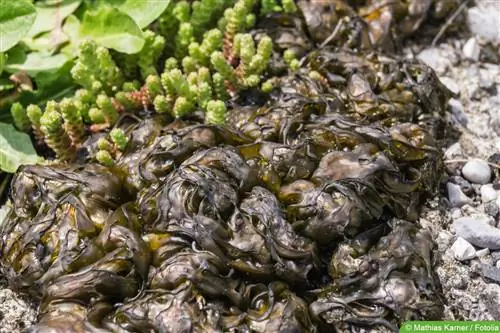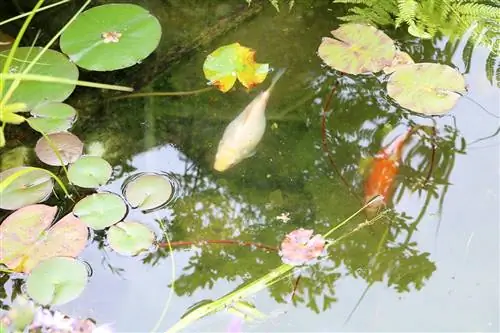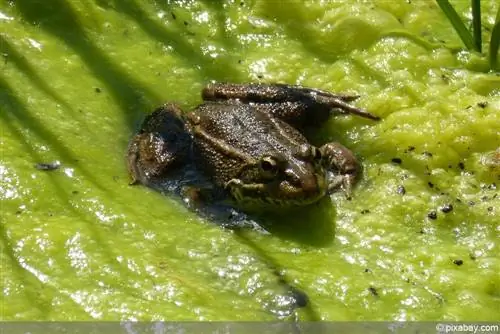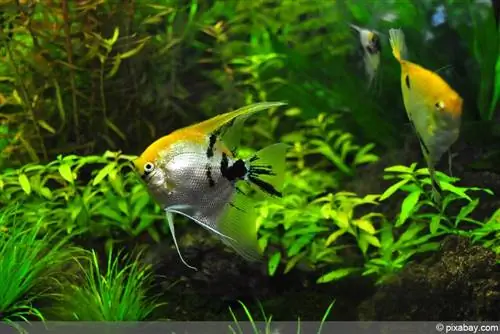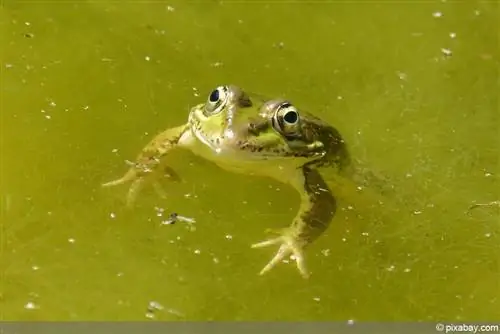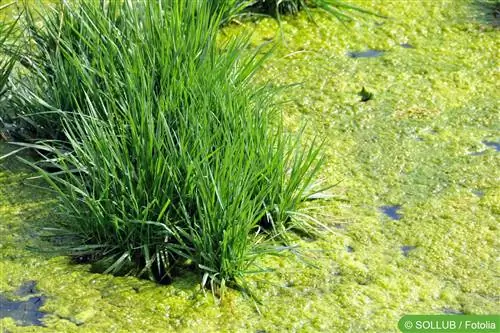- Author admin [email protected].
- Public 2023-12-17 03:39.
- Last modified 2025-01-24 12:45.
Algae in the lawn closes soil pores and prevents grass roots from absorbing sufficient water, air and nutrients. In the next dry period they must be specifically removed, otherwise the affected lawns will die.
Three types of algae as pests
It is mostly blue-green algae (cyanobacteria), green algae (Chlorophyta) or diatoms (Bacillariophyceae) that spread across wet garden areas. Lawn grasses do not harm them directly, but they deprive them of their livelihood because they seal the soil and act as competitors.
- Grasses can absorb fewer nutrients
- they suffer from lack of oxygen
- get less light
- getting weaker and weaker
- as a result they disappear completely
When the grass dies, unsightly bare spots remain that do not regenerate on their own. To avoid this scenario and costly lawn renovation, all visible traces of algae should be removed promptly.
Tip:
After a dry period, the algae problem seems to have resolved itself. But that's deceptive! Algae survive long dry periods and continue to grow as soon as they receive more moisture. So don't miss out on fighting it!
The ideal time for combating
Although the green-black, slippery and often fibrous mass is seen after rainy seasons. A dry period is ideal for elimination. A few sunny days will cause it to shrink and crust over, making it easier to remove from the lawn.
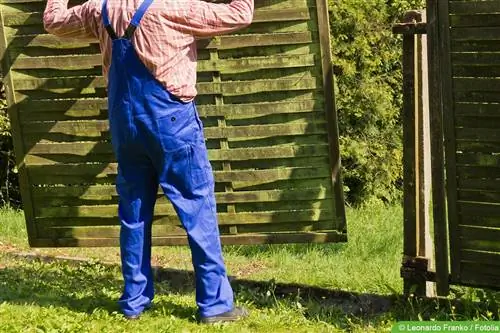
Algae removal instructions
The algae has the ability to reproduce from the smallest remnants under favorable conditions. Therefore, the fight must be carried out very thoroughly. This is usually done manually and time-consuming.
- Remove the entire algae crust. You can use a rake or remove the mixture with a flat, sharp spade.
- Prick the cleaned areas deeply several times with a digging fork to loosen the soil.
- Mix coarse sand and sifted compost and replace the removed soil.
- Scatter new lawn seeds immediately on bare spots.
- Spread a thin layer of lawn soil over it.
Tip:
Do not put the algae residue on the compost as it can spread again from there. Instead, put them in a plastic bag, which you close when you're done and throw it in the trash can.
Chemical control
The laborious process of removing algae by hand almost calls for a chemical solution. In fact, some moss preparations also help in this case. But since the algae is only dried out, this quick solution only lasts until the next wet period. In the long run, there is no way to combat the cause, especially if the problem repeats itself regularly.
Causes of stubborn algae infestation
Blue and green algae occur naturally in the soil. They only become a visible problem when they multiply explosively. If algae infestation occurs again and again, the cause cannot only be found in large amounts of precipitation. A compacted soil may mean that the water cannot seep away easily. Inadequate lawn care is in turn responsible for weak turf, which can hardly resist algae infestation.
Renovating a compacted lawn
Large, heavily damaged lawns on compacted soil should be extensively renovated in spring or autumn. This includes the following steps:
- Mowing at the shortest setting
- Verticulate until all weeds are removed
- Spreading a seed mixture (completely with a spreader)
- Fertilizing with a special starter fertilizer
- Watering with a sprinkler hose
Also cover the turf with a two centimeter thick layer of building sand. If you repeat the procedure several years in a row, the soil will become much more permeable.
Preventive care measures
In order to prevent renewed or general algae infestation, you should take targeted, helpful care measures every year. But don't start this too early in the year. Even if the days are warm, the ground stays cold for a long time. Don't start lawn care until April/May.
- Verticify the lawn regularly and aerate it if necessary
- preferably several times a year
- Mow the grass regularly (no deeper than 4 cm)
- fertilize in a targeted manner and as needed
- if applicable Check nutrient content with soil sample
- Strengthen turf with autumn fertilization
- water without causing waterlogging
- Adjust grass variety to site conditions
Tip:
Shaded lawns stay wet for longer and are therefore more susceptible to algae infestation. Sow robust shade lawns here or use ground-covering plants. In the interests of nature, a pure rock garden is not a good alternative.
Nostoc commune
Nostoc commune is a cyanobacteria. Outside of a garden pond, they can mainly be found on stone slabs and paths. But the lawn is not completely safe from them either. In dry times the colony is only very thin and can hardly be seen. After a heavy downpour, the bacteria form small green and slimy balls. The bacterium is not only harmless, but also helpful. It secretes ammonium, which can serve as a good fertilizer for grass plants. The balls “disappear” as soon as it gets dry. But they come back with the next rain. Despite their harmlessness, many people find them disgusting. That's why they're being fought against.
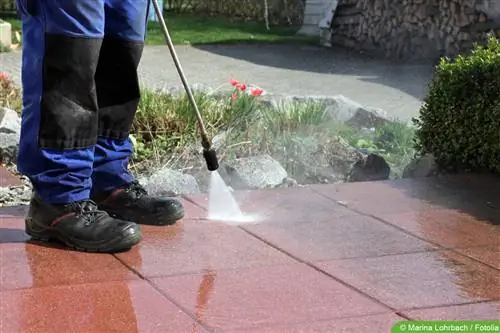
Eliminate Nostoc commune
Sprinkling lime is often recommended. But all it does is ensure that water is removed from the balls. The algae is alive and will come back in the next wet period. Instead of drying them out, it's better to fight them effectively. Depending on which garden area was populated, the procedure is different:
- removing from lawns with a rake
- Use a hard broom or high-pressure cleaner on plates
- Remove the top layer of soil from open areas by a few centimeters
- always dispose of as residual waste
It is hardly possible to completely remove all Nestoc balls from the garden. Here too, it is important to immediately cover cleared areas with grass or other plants. Otherwise a new colony will soon emerge.

